Building materials distributor GMS (NYSE:GMS) fell short of analysts’ expectations in Q2 CY2024, with revenue up 2.8% year on year to $1.45 billion. It made a non-GAAP profit of $1.93 per share, down from its profit of $2.40 per share in the same quarter last year.
Is now the time to buy GMS? Find out by accessing our full research report, it’s free.
GMS (GMS) Q2 CY2024 Highlights:
- Revenue: $1.45 billion vs analyst estimates of $1.49 billion (2.5% miss)
- EPS (non-GAAP): $1.93 vs analyst expectations of $2.14 (9.8% miss)
- Gross Margin (GAAP): 31.2%, in line with the same quarter last year
- EBITDA Margin: 10.1%, down from 12.3% in the same quarter last year
- Free Cash Flow was -$31.92 million compared to -$6.89 million in the same quarter last year
- Organic Revenue fell 2.2% year on year (2% in the same quarter last year)
- Market Capitalization: $3.58 billion
“During our first quarter of fiscal 2025, the GMS team delivered net sales of $1.4 billion, net income of $57.2 million and Adjusted EBITDA of $145.9 million amid what has quickly become a more challenging market environment,” said John C. Turner, Jr., President and CEO of GMS.
Founded in 1971, GMS (NYSE:GMS) distributes specialty building materials including wallboard, ceilings, and insulation products, to the construction industry.
Building Material Distributors
Supply chain and inventory management are themes that grew in focus after COVID wreaked havoc on the global movement of raw materials and components. Building materials distributors that boast reliable selection and quickly deliver products to customers can benefit from this theme. While e-commerce hasn’t disrupted industrial distribution as much as consumer retail, it is forcing investment in digital capabilities to communicate with and serve customers everywhere. Additionally, building materials distributors are at the whim of economic cycles that impact the capital spending and construction projects that can juice demand.
Sales Growth
Examining a company’s long-term performance can provide clues about its business quality. Any business can put up a good quarter or two, but the best consistently grow over the long haul. Thankfully, GMS’s 11.7% annualized revenue growth over the last five years was impressive. This shows it expanded quickly, a useful starting point for our analysis. 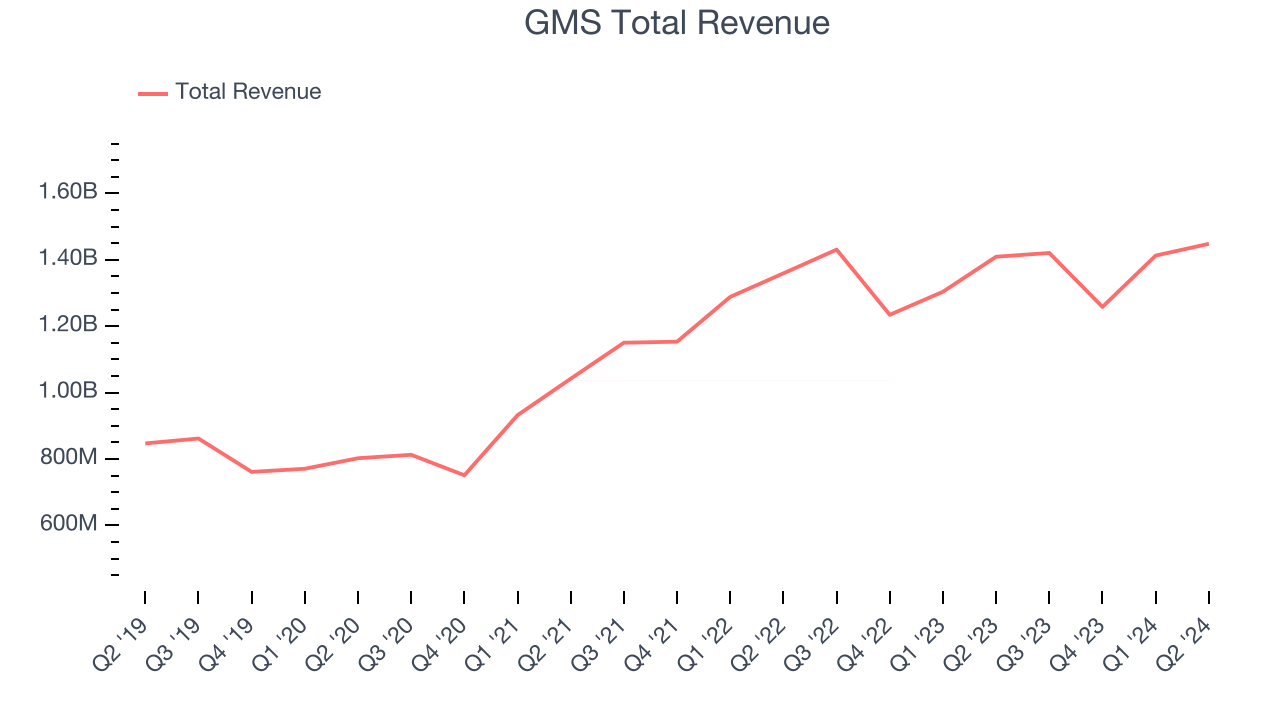
Long-term growth is the most important, but within industrials, a half-decade historical view may miss new industry trends or demand cycles. GMS’s recent history shows its demand slowed significantly as its annualized revenue growth of 5.8% over the last two years is well below its five-year trend.
We can dig further into the company’s sales dynamics by analyzing its organic revenue, which strips out one-time events like acquisitions and currency fluctuations because they don’t accurately reflect its fundamentals. Over the last two years, GMS’s organic revenue averaged 3.7% year-on-year growth. Because this number is lower than its normal revenue growth, we can see that some mixture of acquisitions and foreign exchange rates boosted its headline performance. 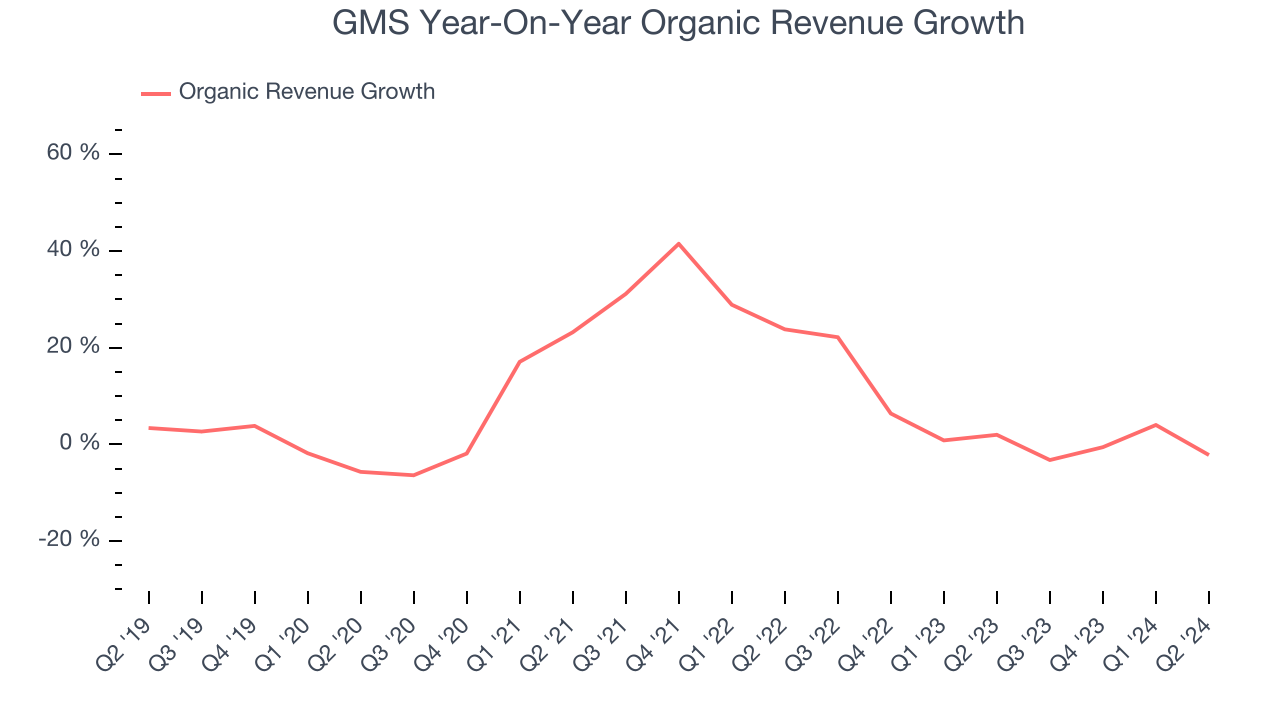
This quarter, GMS’s revenue grew 2.8% year on year to $1.45 billion, falling short of Wall Street’s estimates. Looking ahead, Wall Street expects sales to grow 6.5% over the next 12 months, an acceleration from this quarter.
Here at StockStory, we certainly understand the potential of thematic investing. Diverse winners from Microsoft (MSFT) to Alphabet (GOOG), Coca-Cola (KO) to Monster Beverage (MNST) could all have been identified as promising growth stories with a megatrend driving the growth. So, in that spirit, we’ve identified a relatively under-the-radar profitable growth stock benefitting from the rise of AI, available to you FREE via this link.
Operating Margin
Operating margin is one of the best measures of profitability because it tells us how much money a company takes home after procuring and manufacturing its products, marketing and selling them, and, most importantly, keeping them relevant through research and development.
GMS was profitable over the last five years but held back by its large expense base. It demonstrated mediocre profitability for an industrials business, producing an average operating margin of 7.5%.
On the bright side, GMS’s annual operating margin rose by 4.3 percentage points over the last five years, as its sales growth gave it operating leverage
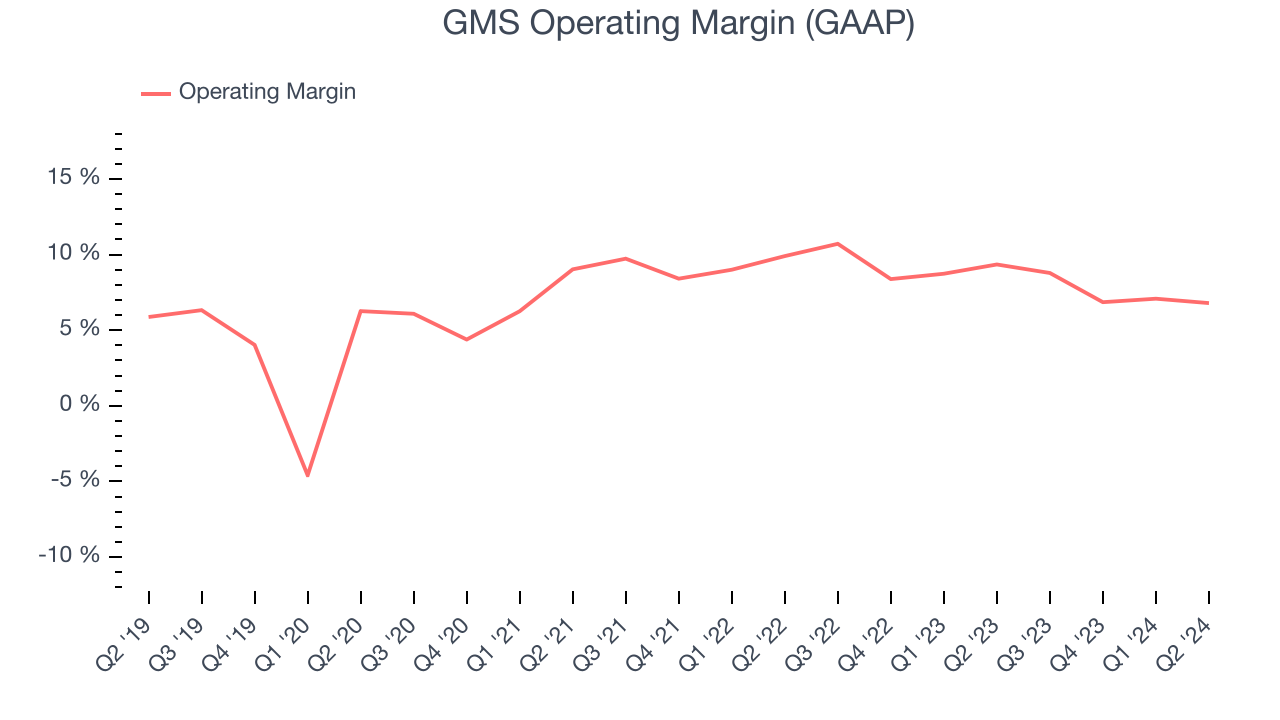
In Q2, GMS generated an operating profit margin of 6.8%, down 2.6 percentage points year on year. Since GMS’s operating margin decreased more than its gross margin, we can assume the company was recently less efficient because expenses such as sales, marketing, R&D, and administrative overhead increased.
EPS
We track the long-term growth in earnings per share (EPS) for the same reason as long-term revenue growth. Compared to revenue, however, EPS highlights whether a company’s growth was profitable.
GMS’s EPS grew at an astounding 22% compounded annual growth rate over the last five years, higher than its 11.7% annualized revenue growth. This tells us the company became more profitable as it expanded.
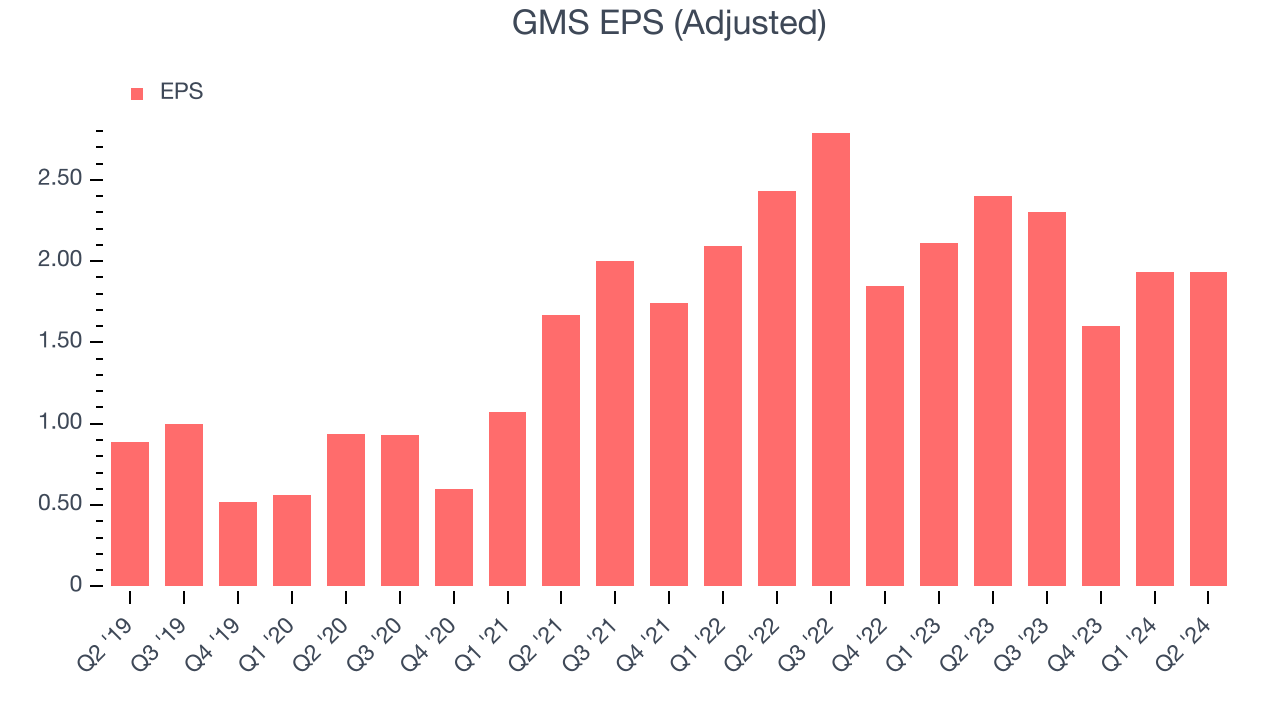
We can take a deeper look into GMS’s earnings quality to better understand the drivers of its performance. As we mentioned earlier, GMS’s operating margin declined this quarter but expanded by 4.3 percentage points over the last five years. Its share count also shrank by 3.3%, and these factors together are positive signs for shareholders because improving profitability and share buybacks turbocharge EPS growth relative to revenue growth. 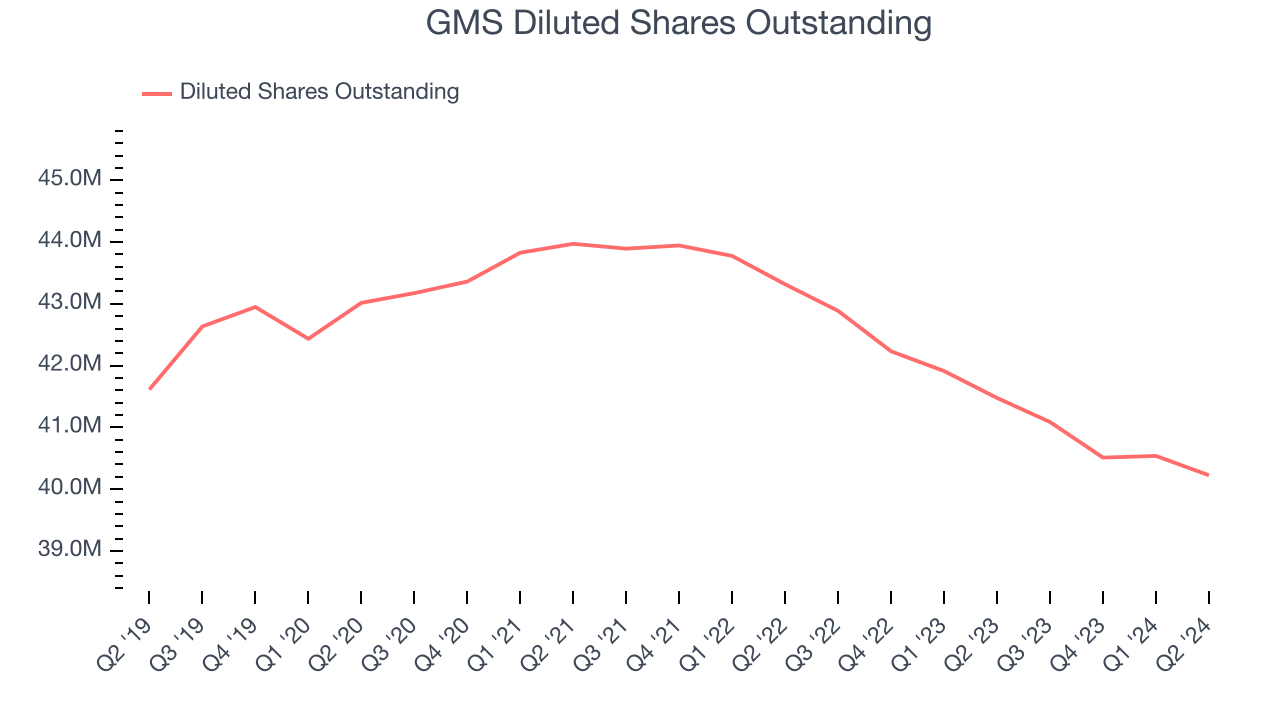
Like with revenue, we also analyze EPS over a shorter period to see if we are missing a change in the business. For GMS, its two-year annual EPS declines of 3.1% show its recent history was to blame for its underperformance over the last five years. We hope GMS can return to earnings growth in the future.
In Q2, GMS reported EPS at $1.93, down from $2.40 in the same quarter last year. This print missed analysts’ estimates, but we care more about long-term EPS growth than short-term movements. Over the next 12 months, Wall Street expects GMS to grow its earnings. Analysts are projecting its EPS of $7.76 in the last year to climb by 10.7% to $8.59.
Key Takeaways from GMS’s Q2 Results
We struggled to find many strong positives in these results. Its revenue unfortunately missed and its EPS fell short of Wall Street’s estimates. Overall, this was a weaker quarter. The stock traded down 6.7% to $85 immediately following the results.
GMS may have had a tough quarter, but does that actually create an opportunity to invest right now? When making that decision, it’s important to consider its valuation, business qualities, as well as what has happened in the latest quarter. We cover that in our actionable full research report which you can read here, it’s free.
